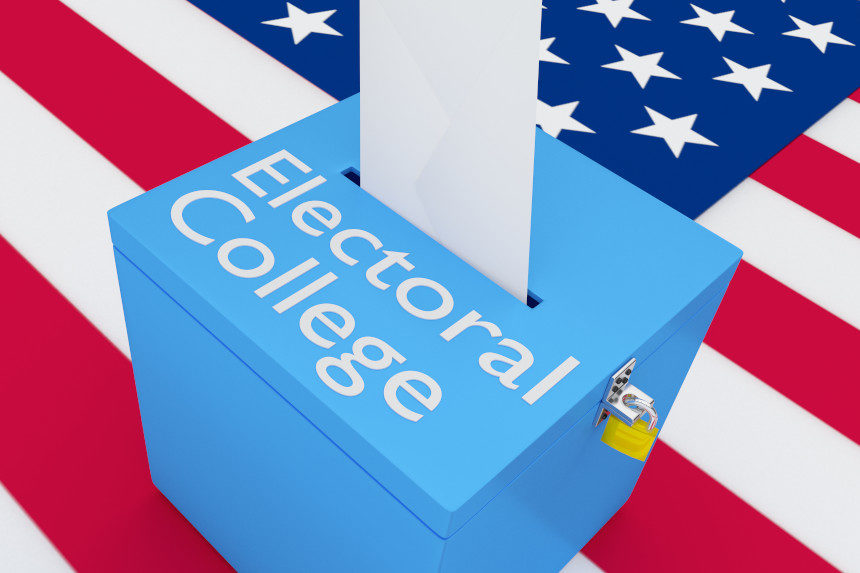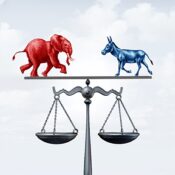In 1916, the election was decided by just 3.1 percent of the popular vote.
John F. Kennedy won the presidency by just 0.2 percent.
And in 2000 the presidency was ultimately decided by just 537 votes.
In the next election, you might be among the handful of voters who decides an election.
Theoretically, your vote for the president has the same impact as any of the other 227,000,000 qualified voters in the U.S. And the candidate with the most votes would win.
But the electoral college changes the weight of your vote depending on where you live. And it can give the presidency to the candidate who may have lost the popular vote.
The last time a candidate won popular vote but lost the electoral college vote was 2016, but it wasn’t the only time. It has occurred 5 times before in our history.
When the electoral college was created in 1787, it was originally intended to balance the electoral power so that Americans in sparsely populated areas weren’t outvoted by the people in the cities. At the time, most Americans were living in rural areas; reducing the electoral power of urban voters would have a limited effect.
Today, the urban/rural division in the population is 80/20, but that rural minority has considerable clout in Washington. After the September 11 attacks, for example, Wyoming received seven times as much Homeland-Security money per capita as New York.
Each state has a set number of electoral votes based on its population. With two exceptions — Maine and Nebraska — the candidate who wins the majority of each state’s popular votes is awarded all of the state’s electoral votes. So within your state, your vote has the same weight as any other voter.
But your electoral college impact depends on your state. Wyoming, for instance, with the lowest population (589,000), has three electoral votes. California, with its population of 39,144,818, has 55.
However, the states’ electoral votes aren’t determined by a uniform calculation. Based on 2016’s returns, Wyoming’s electoral votes were drawn from 586,107 residents, or one electoral vote per 195,369 voters. But California’s electoral votes worked out to one electoral vote for 711,723 voters.
You could say that a Wyoming voter had 3.6 times the weight of a California voter.
This is the most extreme example. But if you do the same math to compare the ten most populous and then least populous states, you’ll find their relative electoral weight is a ratio of 1 (most populous) to 2.5 (least populous).
This fact has led to assertions that voters in low-population states have an undue influence in national politics.
But Dale Durran says this isn’t the only distortion of the representative vote. In an article for theconversation.com, the University of Washington mathematics professor found another factor that will affect your vote’s weight.
He divided the total number of America’s electoral votes — 538 — by the 136 million votes cast in 2016 election. The result was the electoral weight of an average vote: one four-millionth of an electoral vote. But this number, as we’ve seen, is altered by the electoral college. And, he finds, it is also altered by the number of ballots cast within a state. Since the electoral votes are fixed for each state, the weight of each ballot diminishes slightly as more ballots are cast.
If you calculate the electoral college weight of each vote with the voter turnout in the state, Wyoming voters still have the greatest weight (2.97), followed the District of Columbia (2.45), and Vermont (2.42). Florida voters had the least weight: 0.78.
Durran illustrates the point with two states — Oklahoma and Oregon — which have the same number of electoral votes. Because fewer Oklahomans cast their ballots (52 percent) than Oregonians (66 percent), an Oklahoma voter had a weight of 1.22 while an Oregon voter has only 0.89.
His analysis shows that your location can raise the weight of your vote, aside from its electoral college value. The impact of these small numbers of votes in battleground states can make a big difference in who gets elected.
Durran identifies five key states where the 2016 race was close. The electoral votes in four of the states —Wisconsin (10 electoral votes), Michigan (16), Pennsylvania (20), and Florida (29) — were decided by just one percent of the votes.
And these were states whose votes had an electoral college weight of less than 0.85. This means, for instance, that fewer than 27,000 Wisconsin voters decided who got their states’ electoral votes.
If you live in one of these states, your vote may not have the same weight in the electoral college as someone from Wyoming or D.C. But Durran’s analysis shows that a relatively small number of people can make a big difference in the outcome of an election.
So if you decide to stay home on election day, you’re not only giving up your vote, but you’re also conferring additional voting power to another voter – one whose interests and values might be at odds with yours. Even if the math shows your vote doesn’t count quite as much as someone’s else, it’s still your country, and your voice, and your chance to make a difference. So vote.
Featured image: hafakot / Shutterstock
Become a Saturday Evening Post member and enjoy unlimited access. Subscribe now




Comments
Steve, thanks for your comment! If each state was valued equally, you’d have like 10% of the population deciding the entire election. It would be completely unrepresentative of the population as a whole.
Both the popular vote and the electoral vote are flawed. The popular vote would elect the president by a handful of states and the electoral vote gives some states a bit more clout per citizen, but equal representation. In either case most citizens/states are just an after thought in the whole process because of swing states deciding the election. To have candidates truly campaign for your vote across the U.S. (all 50 states) then maybe each state should have equal value. The value of Montana would be equal to California. Each state would give one (1) vote to the candidate that won the popular vote. The candidate that carries the most states would win. In the event that the election ended in a tie (25 to 25), the percentage difference between those who voted Democrat, Republican or Independent per state averaged out across all 50 states would win the election. My 2 cents to this complex and dividing issue.
Thanks for trying to explain the Electoral College, but I still don’t get it or understand the impact of my vote. How was the original law worded?
So New York and Los Angelas would decide for the whole country who would be President?
This a new page I find and is very interesting for me !
Was reading about electoral voting is kind of confusing but some how wish wouldn’t exist if we didn’t have electoral voting , trump wouldn’t be president☹️ . Election should be by popular vote only